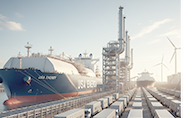Silent cartel: How shipping giants and regulators converge to command the seas
 Once upon a time, the open seas were a bustling, chaotic theatre of commerce, navigated by a colorful fleet of independent carriers, each jostling for advantage in the free market. Once upon a time, the open seas were a bustling, chaotic theatre of commerce, navigated by a colorful fleet of independent carriers, each jostling for advantage in the free market.
Today, however, the international shipping landscape is dominated by a handful of massive conglomerates - MSC, CMA CGM, Maersk, Cosco, Hapag-Lloyd, HMM, and Evergreen whose rise to prominence has been forged through an unrelenting wave of mergers, acquisitions, and strategic alliances. This concentration of power, often unchallenged and quietly applauded by regulators, has yielded troubling consequences for both competition and the supposed neutrality of regulation.
The rise of these giants was not accidental. It came through deliberate consolidation. Maersk acquired P&O Nedlloyd and later Hamburg Sud. CMA CGM absorbed Neptune Orient Lines, the parent company of APL. MSC, while private and famously discreet, has expanded its control organically and through fleet acquisition, buying up second-hand tonnage and increasing its grip on global routes. Cosco, fueled by state capital, absorbed China Shipping and later OOCL, the once-proud Hong Kong-based carrier. HMM, backed by the South Korean government, reemerged from near-collapse with the implicit mission of serving national economic strategy.
Evergreen has remained nominally independent but increasingly bound in global vessel sharing agreements (VSAs) that tie it into the prevailing web of mega-carriers.
What was once a fragmented industry of dozens of competitors is now a tightly knitted network of interdependent giants, bound by alliances. These alliances, originally justified on the grounds of "efficiency" and "cost savings," allow carriers to share vessels and coordinate schedules - a practice that in any other industry would be swiftly challenged by competition watchdogs.
Yet, in shipping, these arrangements have not only been tolerated but encouraged by regulators. The argument is often that the immense capital intensity of operating global container networks necessitates cooperation. But this tolerance comes at a price.
Smaller carriers, which once injected vitality and unpredictability into the market, have been increasingly pushed to the margins or absorbed outright. The few independents that remain are trapped in a world where slot availability, port priority, and economies of scale favour only the giants.
More troubling still is the emerging alliance between these mega-carriers and regulatory authorities on matters of environmental compliance. On the surface, it may appear laudable that the likes of Maersk and CMA CGM are championing decarbonization. Indeed, the shipping industry is under increasing pressure to decarbonize, and the International Maritime Organisation (IMO) has set ambitious net-zero targets.
However, what looks like a noble cause has morphed into a strategic tool for market dominance. The largest carriers now loudly support strict enforcement of environmental regulations - from emissions trading schemes to carbon intensity targets and fuel mandates.
Their reasoning is clear: they can afford it. With state-of-the-art vessels, deeper pockets, and vertically integrated logistics networks, the giants are well positioned to meet regulatory burdens that would overwhelm smaller competitors.
The paradox is that many of these regulations, while symbolically potent, have limited real-world impact on global emissions. A missed target here or a non-compliant fuel tank there does little to change the climate trajectory. And yet, enforcement is insisted upon with religious zeal. The unspoken result is that compliance costs become a defensive moat, shielding the incumbents from rivals.
This unholy alliance between regulator and regulated mirrors patterns seen in other industries. When regulation becomes so burdensome that only the biggest can comply, the result is a de facto cartel legitimized by policy. And in shipping, the consequences are global.
Fewer carriers mean fewer choices for shippers. Port calls are determined not by competition but by alliance strategy. Freight rates, once disciplined by overcapacity and rivalry, are now stickier, and customer service has deteriorated into generic, tech-heavy portals detached from accountability.
The geopolitical implications are not to be dismissed either. State-backed giants like Cosco wield shipping as a tool of foreign policy. Meanwhile, privately held entities like MSC, now the world's largest liner, operate with minimal public transparency despite controlling swathes of terminal infrastructure and intermodal assets. The very notion of national maritime policy is now outdated when the top players owe allegiance to shareholder value.
What is especially worrying is how invisible this concentration has become to the broader public. While regulators fret over Big Tech and Big Pharma, Big Shipping sails under the radar, literally and metaphorically. Antitrust exemptions for shipping alliances persist, relics of a time when carriers were more vulnerable and competition more robust. Today, these exemptions serve as enablers of oligopoly.
To be sure, shipping remains essential. No other industry moves 90 per cent of the world’s trade. But that indispensability is exactly why scrutiny must be more vigorous, not less. The consolidation of shipping power, both horizontally across carriers and vertically into terminals and logistics platforms, has produced a system that is no longer neutral, no longer open, and increasingly beholden to a handful of players with the tacit approval of rulemakers.
The romantic ideal of the high seas as the last bastion of free enterprise is fading. In its place is a tightly controlled matrix of capacity, compliance, and cartel-like behavior. The distressing convergence of liner and regulator should not be ignored. It is one of the most underappreciated dynamics shaping world trade today. |